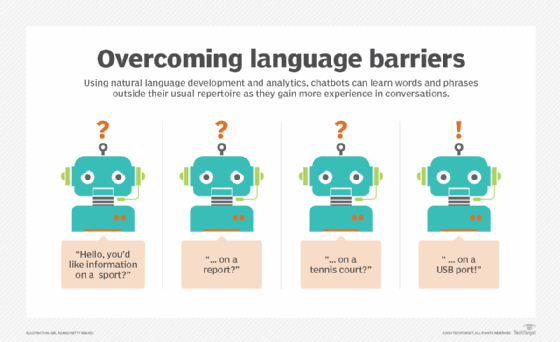What are common uses for cloud AI APIs?
Curious about AI? See top use cases of how cloud-based AI APIs and services can boost application functionality.
With the help of public cloud providers -- such as AWS, Microsoft and Google -- artificial intelligence is becoming more accessible.
To take full advantage of AI, developers first need to decide what kind of features they want to add to their applications. The next step is to examine what AI APIs and services are available from public cloud providers.
Here are some practical applications for specific cloud AI APIs.
Chatbots
Chatbots are the most common example of an AI-driven technology that can be integrated into current applications. They serve various functions and can call on other AI APIs, such as an Amazon Echo that can understand voice commands to search for music. A common use of chatbots is to incorporate text-based interfaces on websites to greet and assist customers. A chatbot can also use natural language processing APIs to improve its understanding and conversational skills.
A variety of public cloud providers offer chatbot services, such as:
- Amazon Lex
- Azure Bot Service
- Google Dialogflow
- IBM Watson Assistant
Image recognition
It can be a chore to find a specific image within a vast collection. If the images aren't meticulously tagged with labels that describe what's in them, it can be difficult to find an image based solely on a text query.
Cloud AI APIs and services -- like Amazon Rekognition, Microsoft Azure Computer Vision API and Google Cloud Vision API -- give applications the ability to parse images and identify elements automatically, even if the images have no useful metadata or descriptions. These image processing APIs can help in a variety of use cases.

Facial recognition is extremely popular with social media apps, but that is only the tip of the iceberg. For example, users can develop apps for building inspectors who need to find images of certain conditions that they've photographed during site visits. Or they could use image recognition to build apps that report weather conditions based on photos or videos captured by remote cameras.
Other common uses of image recognition are object detection and text extraction.
Speech-based user interfaces
A keyboard is not always the best way to enter data. There may be accessibility problems for users who have trouble navigating the keys. It can also be inconvenient when mobile apps lack physical keyboards or if they ask for input when users don't have their hands free.
Developers can integrate cloud AI APIs, such as Amazon Transcribe, Azure Speech to Text and Google Cloud Speech-to-Text to convert speech to text, which saves users from manual data entry. Users are already accustomed to speech-to-text services in certain types of apps, like map and navigation tools. These AI APIs can also recognize speakers and enable voice commands.
Recommendation engines
By now, most consumers are familiar with websites and applications that make recommendations. These sites use purchasing history and user profiles to suggest products or services. In the past, only companies with larger websites, such as Amazon and Netflix, could build data-driven recommendation engines.
Today, however, cloud AI services have significantly lowered the barrier for integrating recommendation engines into applications. AWS offers Amazon Personalize, a machine learning service that creates personalized recommendations, searches and notifications. For Microsoft, there is no out-of-the-box recommendation service, but developers can build a real-time recommendation API with various Azure services, including Databricks. The same can be done on Google Cloud with App Engine, Cloud SQL, Apache Spark and other components.






